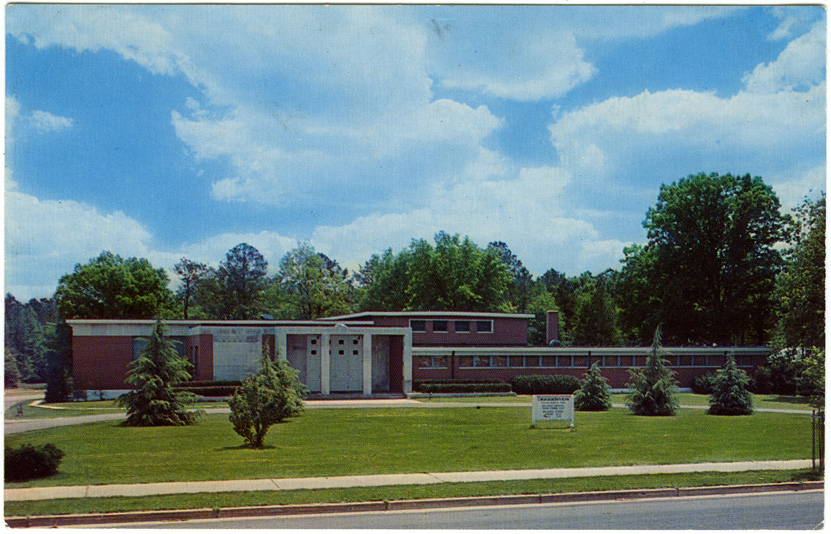10.3 Petersburg, Virginia
Brith Achim, 314 W. South Boulevard
Architect unknown, 1955
Rose Studio, Petersburg, Virginia, publisher; no date; also on the back: “Dexter West Nyack, NY.”
Brith Achim (Covenant of Brothers) in Petersburg, Virginia, dedicated in 1955, is a low, sprawling, asymmetrical brick building in a style favored by many congregations in the 1950s. The building is set back from the road, and the entrance, while facing the street, is skewed toward the parking area. The formal entryway is a simple portico screen of three spare, rectangular spaces between four unadorned piers. Across the top is an inscription: “My House Is a House of Prayer for All People.”
Brith Achim was founded as an Orthodox congregation around 1905, when a cemetery was established, and it affiliated with the Conservative Movement in 1950. This act, and the construction of the modern–style synagogue, confirmed a basic shift in both religious practice and Jewish identity after World War II, when the children of Eastern European Jews most fully identified with American values and cultures and were most firmly embraced as part of the national coalition of established religious groups. Just as classicism had helped the Reform Movement integrate into American urban civic life at the turn of the 20th century, so modernism allowed Jews to integrate into the new and growing world of suburbia. Reflecting this integration, Virginia governor Thomas Stanley spoke at the formal dedication of the building, while Rabbi Solomon Jacobson, who served the congregation from 1951 to 1973, presided.
When founded in the early 20th century, Brith Achim had 37 members, representing only 19 distinct families. Because so many Jewish immigrants followed relatives to Petersburg to partner in business, the new congregation consisted of a handful of extended family networks. In 1915, Brith Achim constructed its first synagogue on North Market Street.
At that time, Petersburg already had a Reform congregation, Rodef Sholom, which dated back to the mid-19th century. As was common at the time, Reform and Orthodox Jews could not and would not see eye to eye and join forces, even in a relatively small town. This tension continued throughout the years; even in the 1950s and 1960s, as both congregations faced demographic decline, efforts at a merger failed. Eventually, in 1975, Rodef Sholom closed entirely and donated its building to the town for use as a public library. Brith Achim remains an active synagogue, but, with few young members, it is unclear how long the congregation can sustain itself—and this simple but striking example of mid-century modern synagogue architecture.
